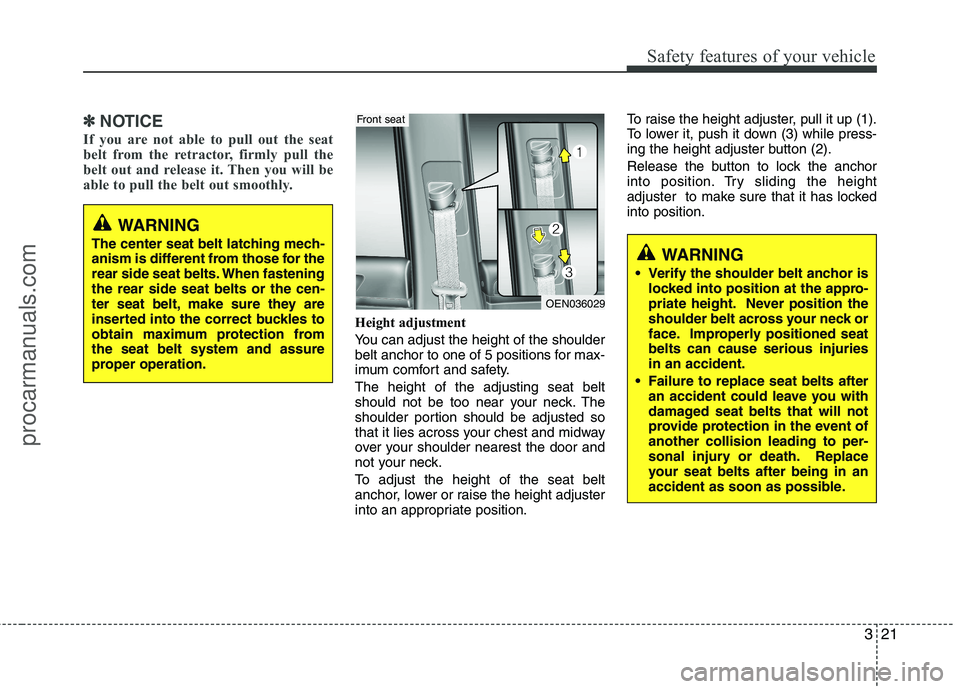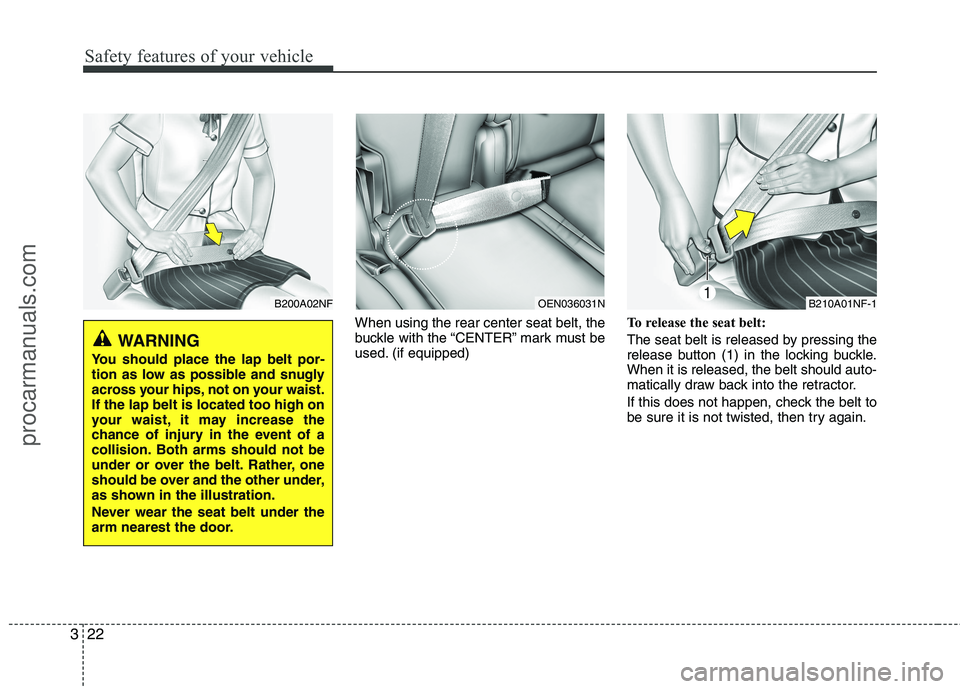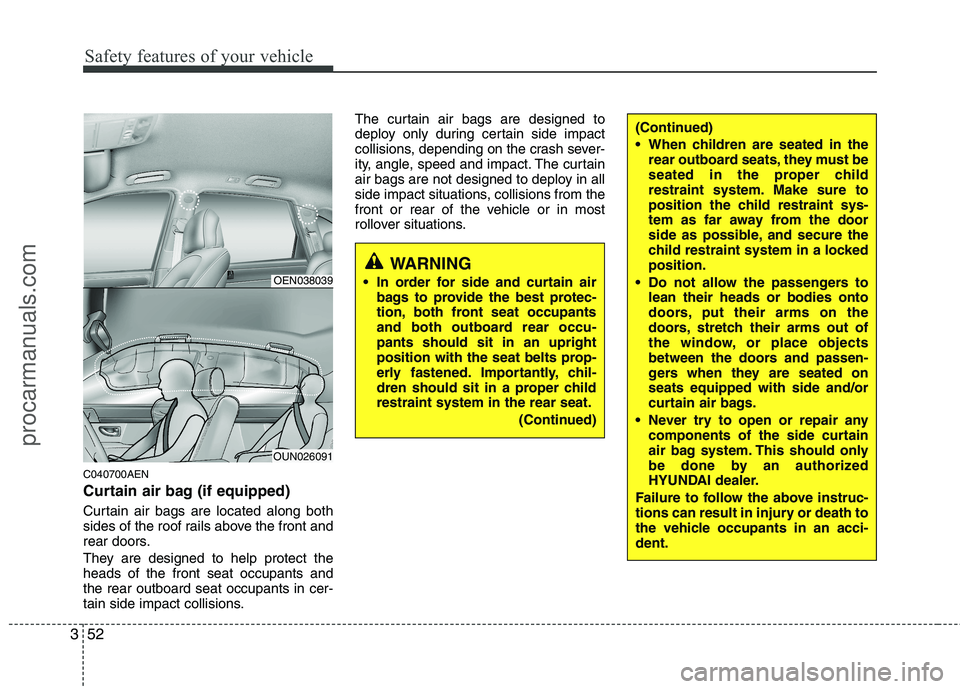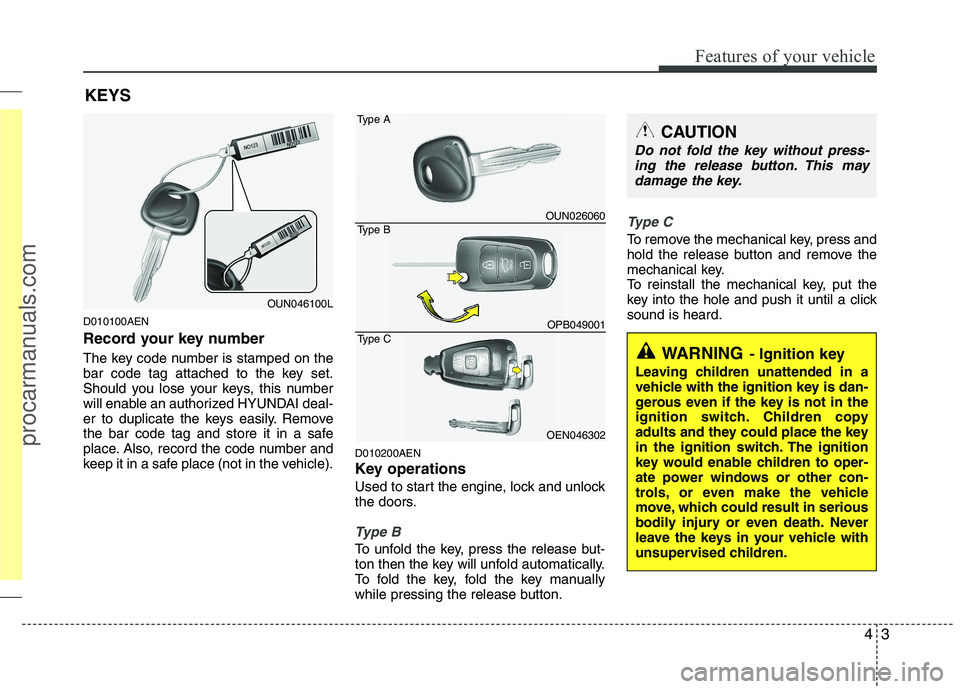2011 HYUNDAI VERACRUZ door lock
[x] Cancel search: door lockPage 13 of 419

Introduction
6
1
INDICATOR SYMBOLS ON THE INSTRUMENT CLUSTER
Seat belt warning light
High beam indicator
Turn signal indicator
ABS warning light (if equipped)
Parking brake & Brake fluid
warning light
Engine oil pressure warning light
4WD system warning light (if equipped)
4WD LOCK indicator (if equipped)
ESP indicator (if equipped)
ESP OFF indicator (if equipped)
Malfunction indicator (if equipped)
Air bag warning light (if equipped)
Cruise indicator (if equipped)
Cruise SET indicator (if equipped)
Immobilizer indicator (if equipped)
Low fuel level warning light
Glow indicator (Diesel only)
Fuel filter warning light (Diesel only)
* For more detailed explanations, refer to “Instrument cluster” in section 4.
Charging system warning light
Low windshield washer fluid
level warning light (if equipped)
A050000BEN-EE
Door (and tailgate) open position indicator (if equipped)
Overspeed warning light (if equipped)
120km/h
Key out indicator (if equipped) KEY
OUT
AIR
BAG
Door ajar warning light (if equipped)
Tailgate open warning light (if equipped)
TPMS (Tire Pressure Monitoring System) malfunction indicator (if equipped)
Low tire pressure telltale (if equipped)
Low tire pressure position tell- tale (if equipped)
procarmanuals.com
Page 15 of 419

Your vehicle at a glance
2
2
INTERIOR OVERVIEW
1. Door lock/unlock button ....................4-14
2. Driver position memory system
button*...............................................4-37
3. Outside rearview mirror folding button*...............................................4-48
4. Outside rearview mirror control switch ................................................4-47
5. Central door lock switch....................4-14
6. Power window lock button ................4-27
7. Power window switches ....................4-24
8. Air vent ..............................................4-90
9. Front fog light switch*........................4-76
10. Head lamp leveling device*.............4-77
11. Rear fog light switch* .....................4-77
12. Instrument panel illumination control knob ................................................4-50
13. 4WD LOCK button*.........................5-16
14. ESP OFF button* ............................5-26
15. Power tailgate main control button* 4-19
16. Steering wheel power tilt control* ...4-40
17. Steering wheel ................................4-39
18. Fuse box .........................................7-46
19. Hood release lever ..........................4-28
20. Parking brake pedal ........................5-22
21. Brake pedal .....................................5-21
22. Accelerator pedal ..............................5-6
23. Seat...................................................3-2
* : if equipped OEN006001L
B010000AEN-EE
procarmanuals.com
Page 39 of 419

321
Safety features of your vehicle
✽✽NOTICE
If you are not able to pull out the seat
belt from the retractor, firmly pull the
belt out and release it. Then you will be
able to pull the belt out smoothly.
Height adjustment
You can adjust the height of the shoulder
belt anchor to one of 5 positions for max-
imum comfort and safety. The height of the adjusting seat belt
should not be too near your neck. The
shoulder portion should be adjusted so
that it lies across your chest and midway
over your shoulder nearest the door and
not your neck.
To adjust the height of the seat belt
anchor, lower or raise the height adjuster
into an appropriate position. To raise the height adjuster, pull it up (1).
To lower it, push it down (3) while press-
ing the height adjuster button (2).
Release the button to lock the anchor
into position. Try sliding the height
adjuster to make sure that it has lockedinto position.
WARNING
Verify the shoulder belt anchor is locked into position at the appro-
priate height. Never position the
shoulder belt across your neck or
face. Improperly positioned seatbelts can cause serious injuriesin an accident.
Failure to replace seat belts after an accident could leave you with
damaged seat belts that will not
provide protection in the event ofanother collision leading to per-
sonal injury or death. Replace
your seat belts after being in an
accident as soon as possible.
OEN036029
Front seat
WARNING
The center seat belt latching mech-
anism is different from those for the
rear side seat belts. When fasteningthe rear side seat belts or the cen-
ter seat belt, make sure they are
inserted into the correct buckles to
obtain maximum protection fromthe seat belt system and assure
proper operation.
procarmanuals.com
Page 40 of 419

Safety features of your vehicle
22
3
When using the rear center seat belt, the
buckle with the “CENTER” mark must be
used. (if equipped) To release the seat belt:
The seat belt is released by pressing the
release button (1) in the locking buckle.When it is released, the belt should auto-
matically draw back into the retractor.
If this does not happen, check the belt to
be sure it is not twisted, then try again.
B200A02NFOEN036031N
WARNING
You should place the lap belt por-
tion as low as possible and snugly
across your hips, not on your waist.If the lap belt is located too high on
your waist, it may increase the
chance of injury in the event of a
collision. Both arms should not be
under or over the belt. Rather, one
should be over and the other under,
as shown in the illustration.
Never wear the seat belt under the
arm nearest the door.
B210A01NF-1
procarmanuals.com
Page 59 of 419

341
Safety features of your vehicle
WARNING
Extreme Hazard! Do not use a rearward facing child restraint on
a seat protected by an air bag in
front of it!
Never put a child restraint in the front passenger’s seat. If the front
passenger air bag inflates, it cancause serious or fatal injuries.
When children are seated in the rear outboard seats of a vehicle
equipped with side and/or curtain
air bags, be sure to install the
child restraint system as far away
from the door side as possible,
and securely lock the childrestraint system in position.
Inflation of side and/or curtain air
bags could cause serious injury
or death to an infant or child.
C040902AEN
Noise and smoke
When the air bags inflate, they make a
loud noise and they leave smoke and
powder in the air inside of the vehicle.
This is normal and is a result of the igni-
tion of the air bag inflator. After the air
bag inflates, you may feel substantial dis-
comfort in breathing due to the contact of
your chest with both the seat belt and the
air bag, as well as from breathing the
smoke and powder. Open your doors
and/or windows as soon as possible
after impact in order to reduce dis-
comfort and prevent prolonged expo-
sure to the smoke and powder.
Though the smoke and powder are non-
toxic, they may cause irritation to the skin
(eyes, nose and throat, etc). If this is the
case, wash and rinse with cold waterimmediately and consult a doctor if the
symptom persists. C040903AEN
Do not install a child restraint on the
front passenger’s seat.
Never place a rear-facing child restraint
in the front passenger’s seat. If the air
bag deploys, it would impact the rear-fac-
ing child restraint, causing serious or
fatal injury.
In addition, do not place front-facing child
restraints in the front passenger’s seat
either. If the front passenger air bag
inflates, it could cause serious or fatal
injuries to the child.
1JBH3051
WARNING
When the air bags deploy, the air
bag related parts in the steeringwheel and/or instrument panel
and/or in both sides of the roof rails
above the front and rear doors are
very hot. To prevent injury, do not
touch the air bag storage area’s
internal components immediately
after an air bag has inflated.
procarmanuals.com
Page 70 of 419

Safety features of your vehicle
52
3
C040700AEN
Curtain air bag (if equipped)
Curtain air bags are located along both
sides of the roof rails above the front and
rear doors.
They are designed to help protect the heads of the front seat occupants andthe rear outboard seat occupants in cer-
tain side impact collisions. The curtain air bags are designed to
deploy only during certain side impact
collisions, depending on the crash sever-
ity, angle, speed and impact. The curtain
air bags are not designed to deploy in all
side impact situations, collisions from the
front or rear of the vehicle or in most
rollover situations.
WARNING
In order for side and curtain air bags to provide the best protec-
tion, both front seat occupants
and both outboard rear occu-pants should sit in an upright
position with the seat belts prop-
erly fastened. Importantly, chil-
dren should sit in a proper childrestraint system in the rear seat.
(Continued)
(Continued)
When children are seated in therear outboard seats, they must be
seated in the proper child
restraint system. Make sure to
position the child restraint sys-
tem as far away from the door
side as possible, and secure the
child restraint system in a lockedposition.
Do not allow the passengers to lean their heads or bodies onto
doors, put their arms on the
doors, stretch their arms out of
the window, or place objects
between the doors and passen-
gers when they are seated onseats equipped with side and/or
curtain air bags.
Never try to open or repair any components of the side curtain
air bag system. This should only
be done by an authorized
HYUNDAI dealer.
Failure to follow the above instruc-
tions can result in injury or death to
the vehicle occupants in an acci-dent.
OEN038039
OUN026091
procarmanuals.com
Page 79 of 419

4
Keys / 4-3
Smart key / 4-5
Remote keyless entry / 4-8
Theft-alarm system / 4-11
Door locks / 4-13
Tailgate / 4-17
Windows / 4-24
Hood / 4-28
Fuel filler lid / 4-30
Sunroof / 4-33
Driver position memory system / 4-37
Steering wheel / 4-39
Mirrors / 4-41
Instrument cluster / 4-49
Rear parking assist system / 4-69
Rear view camera / 4-72
Hazard warning flasher / 4-72
Lighting / 4-73
Wipers and washers / 4-79
Interior light / 4-84
Defroster / 4-88
Manual climate control system / 4-89
Automatic climate control system / 4-101
Features of your vehicle
procarmanuals.com
Page 81 of 419

43
Features of your vehicle
D010100AEN
Record your key number
The key code number is stamped on the
bar code tag attached to the key set.
Should you lose your keys, this number
will enable an authorized HYUNDAI deal-
er to duplicate the keys easily. Remove
the bar code tag and store it in a safe
place. Also, record the code number and
keep it in a safe place (not in the vehicle).D010200AEN
Key operations
Used to start the engine, lock and unlock
the doors.
Type B
To unfold the key, press the release but-
ton then the key will unfold automatically.
To fold the key, fold the key manually
while pressing the release button.
Type C
To remove the mechanical key, press and
hold the release button and remove the
mechanical key.
To reinstall the mechanical key, put the
key into the hole and push it until a clicksound is heard.
KEYS
OUN046100L
OUN026060
OPB049001
OEN046302
Type A
Type BType C
CAUTION
Do not fold the key without press- ing the release button. This may
damage the key.
WARNING - Ignition key
Leaving children unattended in a
vehicle with the ignition key is dan-
gerous even if the key is not in the
ignition switch. Children copy
adults and they could place the key
in the ignition switch. The ignition
key would enable children to oper-
ate power windows or other con-
trols, or even make the vehicle
move, which could result in serious
bodily injury or even death. Never
leave the keys in your vehicle with
unsupervised children.
procarmanuals.com